Concrete Surface Retarders Market Overview
The Global Concrete Surface Retarders Market Size was valued at $82.7 million in 2021, and is projected to reach $131.5 million by 2031, growing at a CAGR of 4.7% from 2022 to 2031. This is growing due to increased construction activities and the rising popularity of decorative concrete finishes in residential and commercial projects. Demand is also fueled by eco-friendly, low-VOC formulations and advancements in product technology, aligning with the global shift toward sustainable and green building practices.
Market Dynamics & Insights
- The concrete surface retarders industry in Asia-Pacific held a significant share of over 67% in 2021.
- The concrete surface retarders industry in Canada is expected to grow significantly at a CAGR of 4.0% from 2022 to 2031
- By type, water based segment is one of the dominating segments in the market and accounted for the revenue share of over 69.6% in 2021.
- By application, application segment is the fastest growing segment in the market.
Market Size & Future Outlook
- 2021 Market Size: $82.7 Billion
- 2031 Projected Market Size: $131.5 Billion
- CAGR (2022-2031): 4.7%
- Asia-Pacific: Largest market in 2021
- Asia-Pacific: Fastest growing market
What is Meant by Concrete Surface Retarders
Concrete surface retarders are chemicals used for achieving an exposed aggregate concrete surface. These chemicals are applied on the top layer of the concrete slab to delay its setting without affecting the rest of the depth of the concrete slab. After a few hours when the rest of the concrete has set, the top layer which has not yet set is scarped off to finally achieve an exposed aggregate concrete surface. Concrete surface retarders are used in residential as well as commercial building construction.
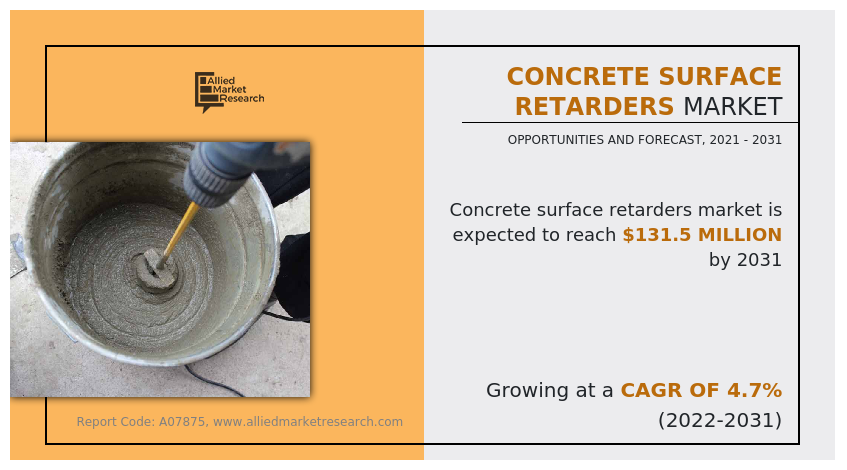
Concrete Surface Retarders Market Dynamics
Throughout the next few decades, the world’s population and urbanization is projected to increase significantly, driving the need for new residential and commercial buildings, The demand for concrete surface retarders is anticipated to rise in tandem with the expansion of the construction industry. Many building developers use concrete surface retarders to create an exposed concrete surface for aesthetic as well as practical purposes. The aesthetic applications include creating a beautiful exterior of a building as well as creating beautiful floors.
Moreover, its practical applications include making the surface resistant to slipping. Exposed concrete surfaces are beneficial in areas such as pool decks, patios, driveways, walkways, and other outdoor public spaces, as well as indoor spaces. In addition, a slip resistant surface is also required in manufacturing facilities. Furthermore, the UN predicts that by 2050, the world’s population is projected to experience growth from its projected 8 billion in 2023 to more than 9.7 billion. If current demographic trends continue, there will be 11 billion people on Earth by the year 2100. Furthermore, the UN also projects that about 68% of the world’s population will be residing in urban areas, up from 55% in 2018.
Most of the estimated growth in urbanization is expected to come from Asia and Africa. As a result, there is growth in the building construction sector of these regions. For instance, in October 2021, the governments of Dubai and India reached an agreement to construct various institutional and infrastructural buildings including college, hospital, logistic center, multipurpose hospital, industrial park, and various other infrastructure. Furthermore, there is a significant increase in the number of small and large retail stores, with developments in economic situation of the general population.
For instance, IKEA is planning to open 30 stores in India by the year 2028. In addition, DLF and other groups are investing millions of dollars in the development of commercial building complexes. Similar trends can be seen in other parts of the world, especially the countries that are still expanding at a significant rate such as China, Vietnam, Indonesia, and others. In addition, there is a growing population of people who are becoming homeless as a result of rising unemployment and rising real estate prices.
As a result, numerous governments across the world, including those of China, South Korea, Canada, UK, and others have developed policies to provide affordable housing. In affordable housing and infrastructure developments, concrete surface retarders are widely used for achieving a strong joint between two separate pours of the concrete. Such developments and expansion of the building construction industry is anticipated to fuel the concrete surface retarders market.
However, concrete surface retarders have few disadvantages, such as it increases the porosity of the concrete slab and decreases the effective depth of the slab. In addition, there is not much awareness regarding the concrete surface retarders. These are few factors restraining the concrete surface retarders market growth.
Moreover, commonly available concrete admixtures such as superplasticizers, retarders, and others in the market are known to be hazardous not only to human health but also affect the environment in a negative way. As a result, there is a continuous demand for building materials that are safe for environment as well as for workers working with them. In particular, concrete surface retarders thar are water-based are better for the environment and are odorless, owing to the fact that it contains very little concentration of volatile organic compounds (VOC) in them. Governments around the world regulate these building chemicals on their volatile organic compound (VOC) content, and encourage the introduction of sustainable concrete surface retarders.
For instance, in 40 CFR 59, the government of U.S. regulates the VOC concentration in the building chemicals. This regulation recommends that the VOC per liter should not exceed 780 grams per liter of concrete surface retarders. Moreover, end users are also becoming aware of the toxicity of various types of surface retarders. Thus, various manufacturers of concrete surface retarders offer a wide range of sustainable concrete surface retarders. For instance, Tenon, a major manufacturer of concrete surface retarders offers Tenon Concrete Surface Retarders which according to the company’s claims is risk-free, non-toxic, and biodegradable. Therefore, rise in demand for environment-friendly building materials is a concrete surface retarders market opportunity for the key players in the concrete surface retarders market.
The demand for concrete surface retarders decreased in 2020, owing to low demand from different industries due to lockdowns imposed by the government of many countries. The COVID-19 pandemic led to the shut-down of production of various products for the construction industry, including concrete surface retarders, mainly owing to prolonged lockdowns in major global countries. This hampered the growth of the concrete surface retarders market significantly during the pandemic.
The major demand for concrete surface retarders was previously noticed from giant countries including the U.S., Germany, Italy, the UK, and China, which were badly affected by the spread of coronavirus, thereby halting demand for concrete surface retarders. However, the severity of the COVID-19 pandemic has significantly reduced, owing to the introduction of various vaccines. This has led to the full-fledged reopening of concrete surface retarders manufacturing companies, and their end-user sectors as well, at their full-scale capacities.
Furthermore, it has been more than two years since the outbreak of this pandemic, and many companies have already shown notable signs of recovery. Contrarily, the increase in number of COVID-19 infection cases in China has brought negative sentiments in the market, which may have a negative impact on the concrete surface retarders market for a short duration. Thus, concrete surface retarders manufacturers must focus on protecting their workforce, operations, and supply chains to respond to immediate crises and find new ways of working after COVID-19 infection cases start to decrease.
Concrete Surface Retarders Market Segmental Overview
The concrete surface retarders market is segmented on the basis of raw material, type, application, and region. By raw material, it is divided into organic agents, and inorganic agents. By type, it is classified into water-based concrete surface retarders and solvent-based concrete surface retarders. By application, it is categorized into residential and commercial. By region, it is analyzed across North America, Europe, Asia-Pacific, and LAMEA.
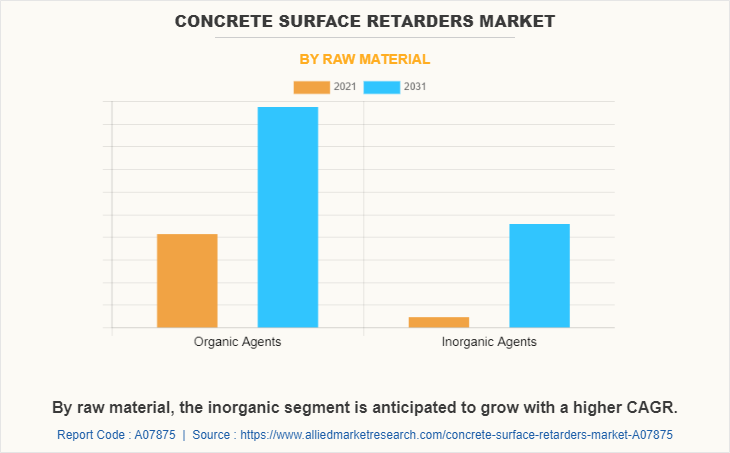
By Raw Material:
The concrete surface retarders market is divided into organic agents, and inorganic agents. In 2021, the organic agents segment dominated the concrete surface retarders market, in terms of revenue, and the inorganic agents segment is expected to grow with a higher CAGR during the forecast period. The organic agents are naturally available chemicals such as lignosulphonates, starch, sugar, and others. Organic agents are known to be more environment-friendly and are less hazardous to the human health. Moreover, the inorganic agents segment includes the inorganic agents such as borates, and others.
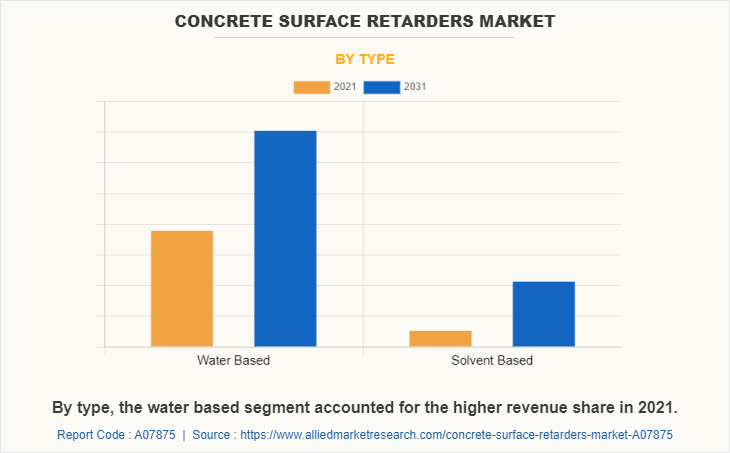
By Type:
The concrete surface retarders market is classified into water-based concrete surface retarders and solvent-based concrete surface retarders. The water-based surface retarders segment was the highest revenue contributor to the concrete surface retarders market in 2021. Water-based concrete surface retarders are easy to use, do not require strict supervision of workers working on the same, and do not require expensive equipment for application and removal. In addition to this, there is no risk of acid residue from strong washing compounds. Furthermore, the solvent-based concrete surface retarders segment is expected to grow with a significant CAGR during the forecast period. The higher CAGR of solvent-based concrete surface retarders is attributed to various advantages, such as high rate of reaction which makes it an ideal choice for large projects.
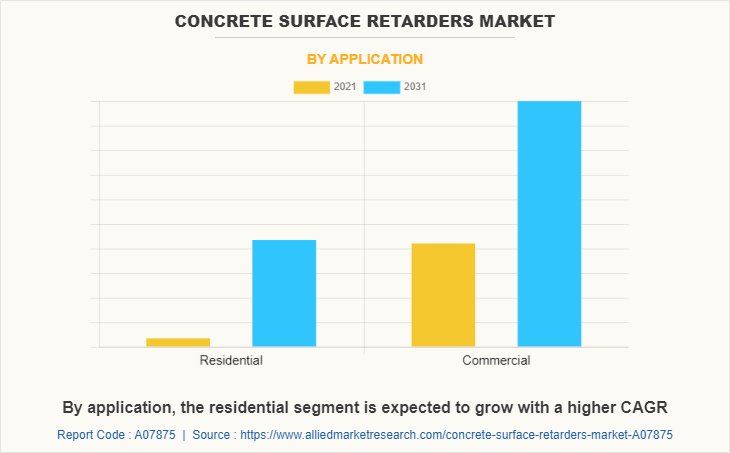
By Application:
The concrete surface retarders market is categorized into residential and commercial. The commercial segment accounted for a larger market share in terms of revenue in 2021. This is attributed to the high demand for decorative building components such as facades and floors. In addition, commercial buildings also utilize concrete surface retarders to achieve a slip-resistant surface in places such as driveways, walkways, and others. Thus, rise in demand for commercial buildings which is attributed rise in urbanization is positively affecting the concrete surface retarders market for commercial buildings. Moreover, the residential segment is expected to grow with a higher CAGR during the forecast period. This higher CAGR is attributed to high growth rate of population in the coming years.
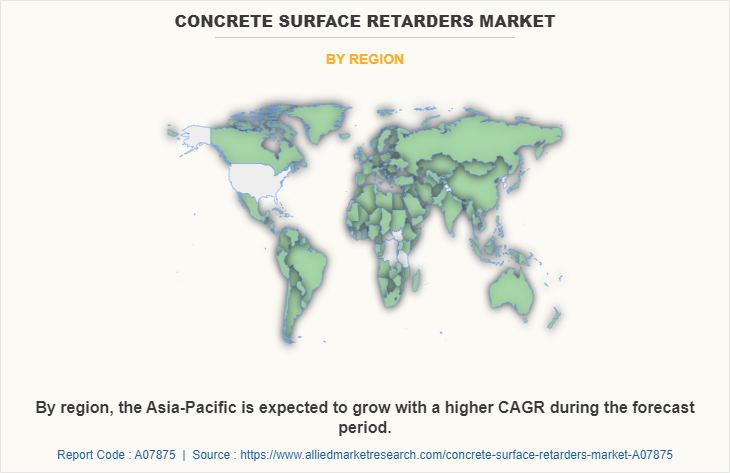
By Region:
The concrete surface retarders market is analyzed across North America, Europe, Asia-Pacific, and LAMEA. In 2021, Asia-Pacific had the highest concrete surface retarders market share and is anticipated to grow with the highest CAGR during the forecast period, attributed to high population growth rate and increase in urbanization. For instance, countries such as China, India, Vietnam, and Indonesia are growing rapidly in terms of population and economy, which is eventually driving the growth of the construction sector, especially the aesthetically appealing commercial and residential buildings. For example, India’s urban population growth is a major driving factor for the growth of the concrete surface retarders market.
For instance, owing to growing urbanization, cities in Inda have become overcrowded and demand for expansion of cities is increasing. For example, government of Haryana state of India has planned to build new city next to the Gurgaon city via public-private partnership. Such factors are expected to open implementation opportunities for concrete surface retarders. Reliance Industries is building a Megacity in Navi Mumbai city of India. This city will be constructed on 4,300 acres of land and will accommodate an ever-growing population of the city.
The project is estimated to cost around $75 billion. Similarly, other countries are also witnessing similar developments. As of 2021, China’s urban population was around 60% of its total population, however, this is estimated to increase to around 70% in 2030. However, the population growth rate in Japan is declining which is expected to have a small negative impact on market growth. Moreover, New Zealand and Australia are developed countries and witness moderate growth in the building construction sector. Since concrete surface retarders are widely used for achieving attractive concrete surfaces, high demand for residential and commercial buildings is driving concrete surface retarders market growth.
Competition Analysis
Competitive analysis and profiles of the major players in the concrete surface retarders, such as Sika AG, BASF SE, MAPEI S.p.A., GCP Applied Technologies Inc., TK Products Construction Coatings, The Euclid Chemical Company, CEMEX S.A.B DE C.V., W. R. Meadows, Inc., RussTech, Inc., and Fosroc, Inc. are provided in this report. Major players have adopted business expansion as key developmental strategies to improve the product portfolio of the concrete surface retarders market. For instance, in May 2022, Sika, a major producer of concrete admixtures including concrete surface retarders opened a new production facility in Stafford, Virginia.
What are the Key Benefits for Stakeholders
- The report provides an extensive analysis of the current and emerging concrete surface retarders market trends and dynamics.
- In-depth concrete surface retarders market analysis is conducted by constructing market estimations for key market segments between 2021 and 2031.
- Extensive analysis of the concrete surface retarders market is conducted by following key product positioning and monitoring of top competitors within the market framework.
- A comprehensive analysis of all the regions is provided to determine the prevailing opportunities.
- The concrete surface retarders market forecast analysis from 2022 to 2031 is included in the report.
- The key players within the concrete surface retarders market are profiled in this report and their strategies are analyzed thoroughly, which help understand the competitive outlook of the concrete surface retarders industry.
Concrete surface retarders Market Report Highlights
| Aspects | Details |
| Market Size By 2031 | USD 131.5 million |
| Growth Rate | CAGR of 4.7% |
| Forecast period | 2021 - 2031 |
| Report Pages | 293 |
| By Raw material |
|
| By Type |
|
| By Application |
|
| By Region |
|
| Key Market Players | TK Products Construction Coatings, MAPEI S.p.A., W. R. Meadows, Inc., CEMEX S.A.B DE C.V., Fosroc, Inc., GCP Applied Technologies Inc., RussTech, Inc., The Euclid Chemical Company, Sika AG, BASF SE |
Analyst Review
The concrete surface retarders market has witnessed significant growth in the past few years, owing to a surge in spending on the construction of residential and commercial buildings.
Concrete surface retarder being a safer and easier method for exposing concrete aggregate for aesthetical purposes, as well as for creating a slip-resistant surface is witnessing increased demand. Furthermore, concrete surface retarders are used in buildings and other infrastructures such as bridges, for leaving a rough surface on concrete to allow a strong joint between different pours of concrete. Moreover, water-based concrete surface retarders are expected to witness an increased demand owing to strict government regulations related to the volatile organic compounds present in concrete surface retarders. However, few disadvantages of concrete surface retarders that make concrete vulnerable to crack, and reduced effective strength limits the market growth.
The growth in infrastructural development projects, and increased demand for residential, commercial, and industrial buildings, are few of the upcoming trends of Concrete surface retarders Market in the world.
Concrete surface retarders are widely used in commercial construction for achieving an exposed aggregate concrete surface.
Asia-Pacific accounted for the largest market share in terms of revenue in 2021.
The global concrete surface retarders market size was valued at $82.7 million in 2021.
Key companies profiled in the concrete surface retarders market report include Sika AG, BASF SE, MAPEI S.p.A., GCP Applied Technologies Inc., TK Products Construction Coatings, The Euclid Chemical Company, CEMEX S.A.B DE C.V., W. R. Meadows, Inc., RussTech, Inc., and Fosroc, Inc.
The global concrete surface retarders market size is projected to reach $131.5 million by 2031.
By application, the commercial segment accounted for a larger market share in 2021.
The company profile has been selected on factors such as geographical presence, market dominance (in terms of revenue and volume sales), various strategies and recent developments.
Loading Table Of Content...



